1976 Spanish Grand Prix race report
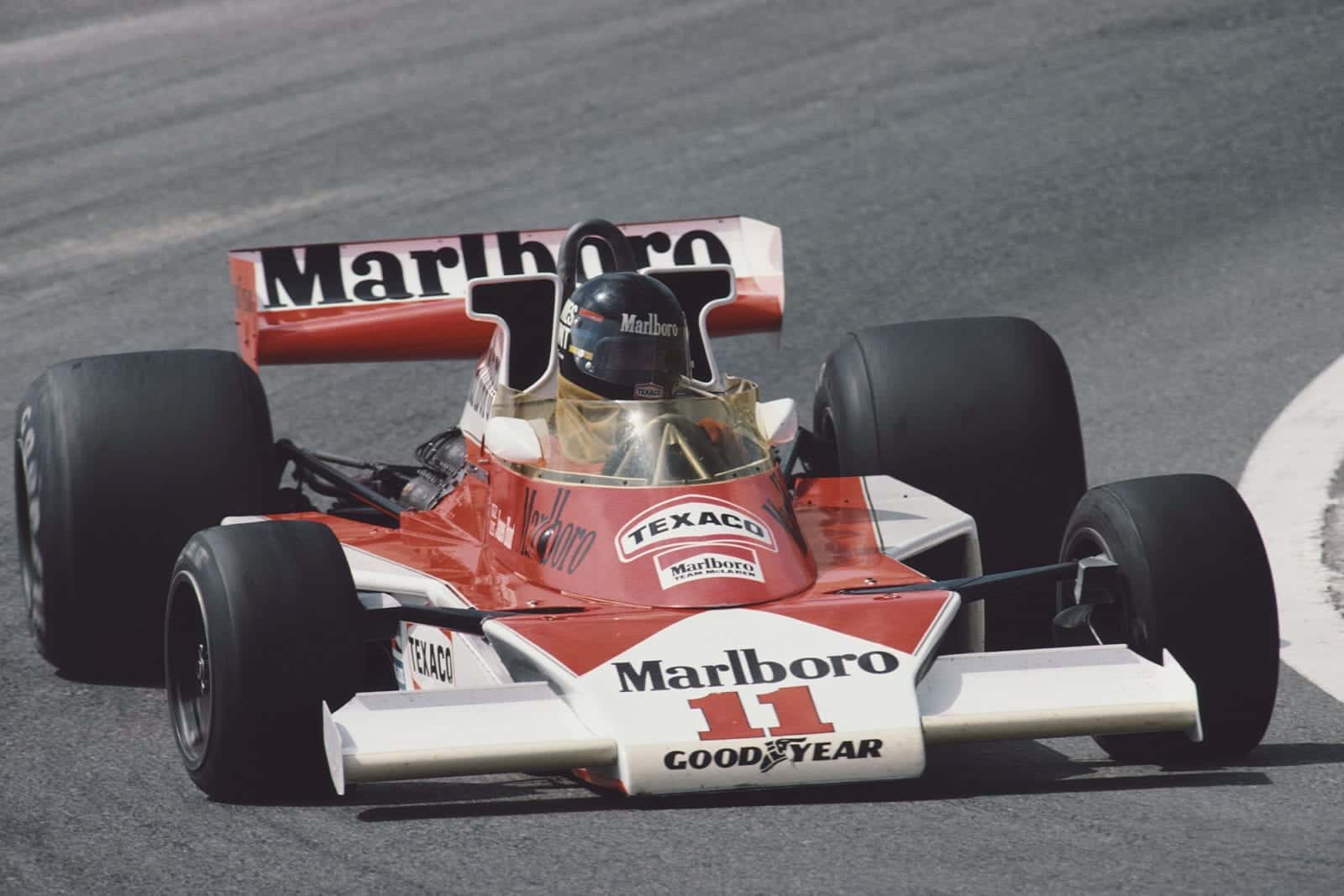
James Hunt took his first win for McLaren at Jarama before being disqualified
Motorsport Images
Qualifying
Official practice at a permanent Autodrome like Jarama is fast becoming a simple formality, or at least it should be, for most of the teams were out testing during the week before the meeting began. Only the less affluent ones like Shadow and March were unable to join in until the official sessions began, but as they are not regular front runners it did not affect the issue.
During these unofficial testing days everyone times everyone else and some exaggerated claims are made as a form of “gamesmanship”. Tyres are tested to settle on the most suitable type for the race and suspension, aerodynamics and general handling are all played with in search of the ultimate, consistent lap time.
Some cars, such as the six-wheeled Tyrrell Project 34/2 covered as much as 500 miles, well over 200 laps of the wiggly Autodrome. After all this you would expect each driver to give himself a few shake-down laps when official practice began, and then set a lap time suitable for a good grid position. However, it doesn’t seem to work like that and most drivers used the four practice sessions to the full, clocking up 130 or 140 laps in preparation for a 75-lap race.
One of the problems is that with everyone practising, a driver is lucky to get 10 good, fast, single flying laps out of a total of 40 or more, and then only if he has a trouble-free session.
The unfortunate Copersucar Fittipaldi team never got themselves really clear of trouble, which all began when the prop-shaft broke on the big DAF transporter they had bought off Hesketh. This happened just as they were approaching the Jarama circuit the day before practice was due to begin. They got under way with the two cars on Friday morning and while Emerson Fittipaldi put in 40 laps, with a best of 1 min. 20.71 sec. which was good average, Ingo Hoffman in the later of the two cars only completed three timed laps before there was an almighty bang and a big hole in the side of the Cosworth crankcase and a shower of broken bits in one of the inlet trumpets, so that was the end of his practice and the mechanics set to work to change the engine. The number one March team were also in trouble for Peterson’s blue and yellow car died on the opening lap and it took him a long time to coax it back to the pits, where the electrics were put right. Later the rear aerofoil came loose in its mounting and swung drunkenly round sideways.
The other half of March were not a lot better off for Stuck’s air-box came undone and lay more or less upside-down on top of the engine, the tall German pressing on unheedingly.
Among the “aces” there was concern in the Ferrari pits for Lauda was still black and blue with damaged ribs following an agricultural accident when a tractor digger he was using rolled over on him on his property near Salzburg. Although he was suffering a lot of pain and was very uncomfortable he was driving as well as ever, though in some doubts as to whether he could keep it up for the full race distance. He was so stiff that he could not get out of the Ferrari until mechanics had removed the complete cockpit surround. The usual twist and wriggle up and over the narrow fairing being quite impossible for him.
In the McLaren pits his erstwhile rival James Hunt was sympathetic but not making any allowances for the World Champion’s discomfort. In fact this was just the chink in the Ferrari armour that the McLaren boys needed and they kept the pressure on. Hunt made fastest lap in 1 min. 18.52 sec. to Lauda’s 1 min. 18.84 sec., but Regazzoni was supporting his team-mate well, with third fastest in 1 min. 19.15 sec. Making up for all the troubles in the March teams, Brambilla was his usual spirited self and was fourth fastest, just ahead of Depailler, Nilsson, Mass, Laffite and Pace, these all getting into the one-minute-nineteen-seconds bracket.
It was quite clear that a lap in the one-eighteens was to be “ace” time, with one-nineteens as “good triers” in with a chance. Anything in the order of 1 min. 20 sec. or over was hardly worth bothering about and 1 min. 21 sec. to 1 min. 22 sec. was going to be the back of the grid. After some indecision and discussion it was agreed that 24 cars could start, which meant that six drivers were going to get left out.
While the Ferraris and Hunt were at the front as expected, the biggest surprise for some people was Depailler in fifth place with the six-wheeled Tyrrell. However, anyone watching on the faster corners could not have helped noticing the way the front of the car was really sticking to the road, so much so that the rear end was beginning to look unhappy.
Another pleasant surprise was the driving of the new Swedish star Gunnar Nilsson, who was lifting the Team Lotus spirits with every lap and pronouncing himself very happy with the Lotus 77. His new team-mate Mario Andretti was a bit cautious and settling in the new car with a best lap one second slower than Nilsson.
The Ligier-Matra was reliable if nothing else, putting in 54 laps in this first 1 1/2-hour session, and his time of 1 min. 19.39 sec. was right in there with Mass, Nilsson and Depailler. It was nice to see an all-French team in action, and going well, with French car, French driver, French engineer, French mechanics and the whole equipe financed by French cigarettes and coloured mainly blue. There was a distinct air of Matra about the whole team and very little Ligier, most of the people involved being old familiar faces from the Matra days.
After lunch there was a shorter session, of one hour, but even so Tom Pryce managed to get in 32 laps, still learning his way round the Autodrome, not having been before. Although Hoffman had another engine installed in his Fittipaldi car he still failed to get any practice as it refused to run properly and he did not get a timed lap. Big trouble also moved with the Brabham pit, for Pace’s Alfa Romeo engine went sour on him and he had to go out in the spare car, while preparations were made to change the sick engine. But that was not all for Reutemann went off the course and damaged his car against a particularly strong post supporting the catch-fencing. As the monocoque chassis was damaged it meant that he had to take over the spare car, once Pace’s own car was back in action. While Brambilla was in great form as he always is, Peterson was making little progress, the clutch action on his car being slow so that he was losing time on gear changes, and there are a lot of them at Jarama. Hunt was still making full use of the six-speed McLaren/Hewland gearbox on his car and remained ahead of Lauda and his team-mate Mass, also with a six-speed gearbox, moved up into fifth place. A pleasant surprise was to see Chris Amon heading the mid-field runners with the brand new Ensign N176, the car performing well. The performances of the Shadow team, the Williams team and the Surtees team were not at all outstanding, all their drivers being down amongst the also-rans and not far off the non-qualifiers.
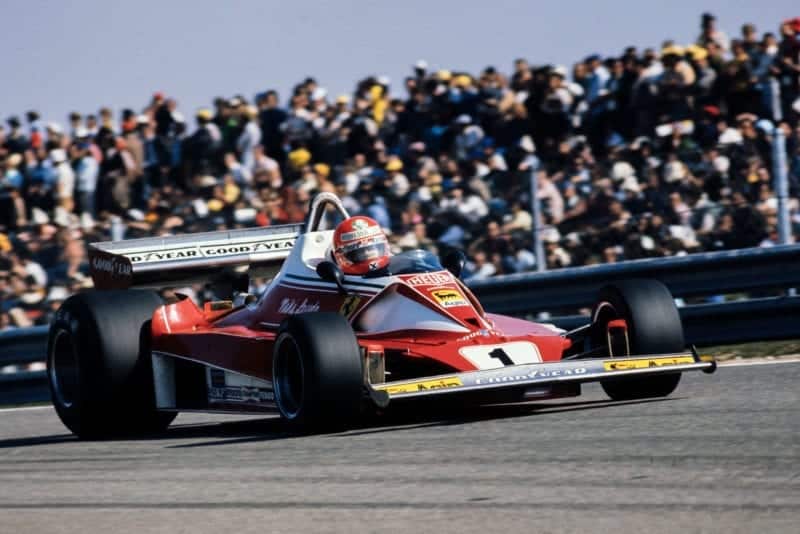
Lauda was second on the grid behind Hunt
Motorsport Images
On Saturday morning, with the weather still fine and clear, though rather cold for Spain, there was a 1 1/2-hour session in which lap times were not counted for the starting grid positions. This is to allow teams to try their cars in racing conditions with full petrol tanks, and also to scrub-in new tyres ready for the race. There was a delay in starting as a track-inspection was taking place due to some concern over the strength of the wooden poles supporting the catch-fencing. Some of them were described as “young trees” and saw-cuts were put into them so that they would snap off cleanly in the event of an accident. This test-session hadn’t been going long before it was all stopped because the Fittipaldi team were in 100% trouble, proving that things can go from bad to worse. Hoffman’s engine was still refusing to run properly, in spite of having come direct from a Cosworth rebuild, and it died altogether at the end of the main straight. Meanwhile, Emerson Fittipaldi had under-estimated the adhesion of his front tyres and under-steered himself off into the catch-fencing at the other end of the circuit, so while the fencing was repaired the Fittipaldi cars were retrieved. The damage to the team-leaders car was very slight but Hoffman’s engine was obviously suffering from valve-gear trouble, spitting back through one of the intakes all the time, so another engine change was started. Pace’s Brabham was back in action, with a new Alfa Romeo engine fitted and Reutemann was settling himself into the spare car. With nothing to lose, Ken Tyrrell sent Scheckter out without the complicated air-box on 007/6-4 leaving the inlet trumpets to breathe from the turbulent air behind the driver’s head, and there seemed to be little loss, or gain! Just as the session was finishing, there was a cloud of smoke from locked wheels at the end of the straight as 13rambilla went beyond the ultimate braking point and the orange March slid helplessly off the track into a sea of pumice granules laid especially on the outside of the corner to decelerate wayward cars before they hit the fences, and it worked beautifully.
Finally there was one hour of timed practice, a sort of mad make-or-break session for the final selection of the fastest twenty-four and a sorting out of those twenty-four into the final grid order. Once more Hunt consolidated his position with fastest time, but not as fast as his first session time and Depailler caused a stir by making second fastest time with the six-wheeled Tyrrell, running without an air-box. Taking a tip from those at the front Perkins ran the 1975 Ensign without its air-box and made his fastest lap of the whole practice, which just got him into the grid in twenty-fourth place. There were no major changes among the front-runners but Laffite was impressive by the sheer reliability of the Ligier-Matra V12, getting in 36 laps in this final hour and achieving a record 142 laps altogether in the two days’ practice (for a 75-lap race!). During the two days the technical commission of the CSI were looking closely at the cars, verifying if all the new rules had been adhered to. it was found that the McLaren rear aerofoils were contravening the 80 cm. overhang rule because the sideplates extended slightly beyond the trailing edge of the wing, but this was easily rectified with a pair of tin-snips. Other contraventions were discovered in teams with tall drivers who sat well up in their cars for their helmets protruded into the line between the highest points of the two roll-over bars. Worst offender in this was Ingo Hoffman, while little E.F., in an identical car, sat well below the datum line. For them it was academic as Hoffman had only managed a total of six timed laps throughout practice. Much more serious was Nilsson, who sat proud of the Lotus 77, while little Andretti was legal in the sister car. To appease the rules a small plate, like a tiny aero-screen was bolted to the front structure to raise the line. Two of the Marches also contravened this rule, surprisingly 13rambilla’s car and, not surprisingly, Hans Stuck’s. Both were made legal by tubular additions to the roll-over bar behind the cockpit. All this was very sad to see for it was reminiscent of Le Mans or Saloon Car scrutineering where cars have silly additions tacked on just to satisfy some footling rule.
The twenty-four cars qualified for the race were a fair and honest selection, with few surprises and no anomalies so all seemed set for a good race. It was hard to award a single “A for effort” as there was worthiness all the way down the twelve rows of the grid, from Hunt’s domination on pole position, with three FTDs, Lauda’s courageous place alongside on the front row, Depailler’s brilliance with six-wheeled Tyrrell in the second row, Laffite and Nilsson side-by-side in the fourth row, Amon in row 5 with the brand-new Ensign and right at the back Perkins on the grid with the little Dutch team’s car, in their first attempt at going-it-alone. As spectators were Lunger (Surtees), ever hopeful as first reserve, the two Spanish drivers Villota and Zapico, the Swiss Kessel, the bearded Austrian journalist Ertl and the unfortunate Hoffman.
Race
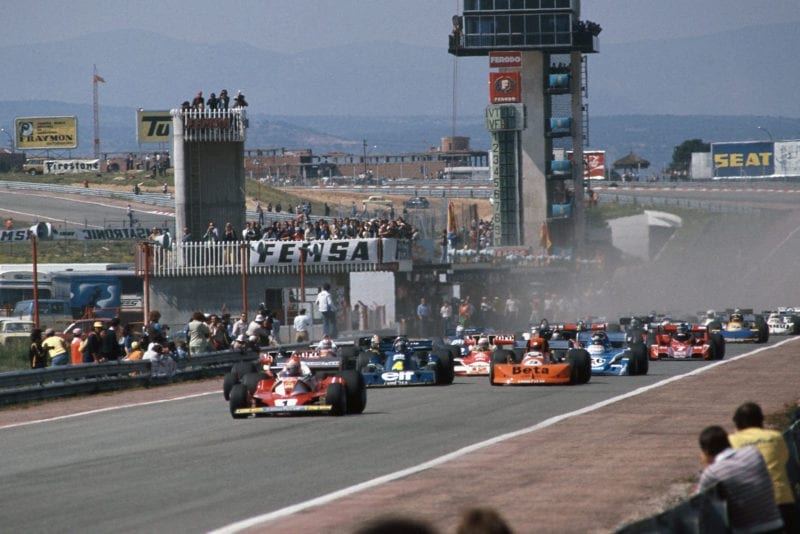
The drivers race off in Spain
Motorsport Images
Race day was a perfect Spanish one with clear blue skies and a hot sun and a good crowd pouring into the circuit. Due to a television tie-up with Brazil and South America the start was not due until 4 p.m., so the morning was pretty leisurely, except that yet another “test session” was permitted at 11 am and everyone thrashed round and round as if they’d never been to Jarama before. The last time the Grand Prix was held at Jarama, in 1974, the race started in the rain and finished in sunshine and the wiseacres all moaned that the race started too early. This time they were moaning because it was starting too late, suggesting that the lovely sunny weather would be gone by 4 p.m. and it would be raining. Some people were suggesting that Formula One racing Should be conducted like USAC small-track racing, with a practice session in the morning and the race in the afternoon, while others said we ought to run Formula One like motorcycle Speedway, with no practice at all, just straight out onto the starting line! There was plenty to talk about during the 4-hour wait for the start.
For various technical reasons on the organising side the start was delayed until 4.15 p.m., but before that the new King of Spain arrived in a most unruly fashion, in a giant helicopter that landed behind the pits in the biggest whirl-pool of dust and rubbish, blowing filth and dirt all over everyone, many of them dressed in their Sunday best to greet the King. By this time all the cars had been wheeled out onto the grid, not in a nice presentation of teams and drivers, but in a straggly, disorganised shambles (and people keep trying to tell me that Formula One racing is entertainment). The King met some of the drivers and then they were allowed one warm-up lap, setting off more or less in grid order one at a time with strict instructions. not to overtake. After Fittipaldi had left his mechanics found a pool of brake fluid where the car had been standing, so while some of them waited for their driver to return, the rest rushed back to the pits to start up Hoffman’s car, which had been race-prepared for just such an emergency. When Fittipaldi arrived back on the dummy-grid it was found that the left-front brake caliper was leaking fluid, so he jumped out and ran all the way back to the pit; (and it was a very long way,. especially in full protective race-gear and helmet). He climbed into Hoffman’s car and set off round the circuit again, While the Start was delayed until he joined the dummy-grid.
Everyone was ready, Hunt and Lauda the 24 ears forward to the starting line, Count Villapadierna, the Clerk of the Course, climbed onto his rostrum, there was, the suspicion of a waved flag and Lauda was gone in a start that the boys at Santa Pod Drag Racing would have been proud of. The rest were bard on his heels, in the order, Hunt, Brambilla, Depailler, Mass and Laffite, Regazzoni muffled his start and got thoroughly boxed in, and Pryce’s Shadow swallowed a lot of dust and the throttle slides jammed shut, so he had to trickle along for half a lap until petrol had washed them clean, by which time everyone Was long gone.
After the initial rush, Brambilla got elbowed back into fifth place, where he rightfully belonged, Depailler going by during the opening lap and Mass On the second lap. Poor Fittipaldi lasted only three laps before a bolt fell out of the gear-lever linkage and he gave tip the unequal struggle, the team not knowing whether to laugh or cry after such an unbelievably bad weekend. On the tight little Jarama autodrome it took five laps before a gap began to appear in the high-speed procession, for “follow-my-leader” has to be the order of the day unless you are very brave Or very skilful and nose-to-tail the order was Lauda, Depailler (Yes! with the six-wheeler Tyrrell), Mass, Brambilla, Laffite, Nilsson and Andretti. After a small gap came Regazzoni, Scheckter, Reutemann, Pace, Jarier, Watson, Peterson (he should have stayed with Lotus!), Amon (a poor opening lap), Stuck, Merzario, Ickx and the tail-enders. On the next lap a definite pattern began to form with Lauda, Hunt, Depailler and Mass drawing away, but in a state of deadlock, with a second race taking place between Brambilla, Laffite, Nilsson, Andretti and Regazzoni, the test trailing behind, while Peterson headed for the pits with his transmission overheating and wondering if he had joined the wrong team for the wrong reason.
At ten laps the scene had settled down into two nice races, with Hunt pressing Lauda as hard as he could, knowing the World Champion’s physical staying power to be suspect, just the way a professional boxer will concentrate on an opponent’s cut eye, or split lip. Laflite overtook Brambilla and moved up into fifth place on lap 12, and Ickx surprised everyone down at the back of the field by overtaking the car in front! As it was Merzario there was little need to get excited, though it is a nor reflection on Formula One racing that it actually evoked comment. When the nice young Belgian overtook Stuck on the next lap things had come to an exciting and enthralling state! This put lckx into seventeenth position in a car that James Hunt had amongst the front runners last year. Once past Brambilla the Ligier-Matra V12 screamed its way ahead, getting away from its pursuers but unable to catch the cars in front. It was now Nilsson’s turn to try and get by the orange March, but Brambilla was not giving any help. As they went by the pits to start lap 19 the black and gold Lotus got into position to push through on the inside under braking and when they arrived at the end of the straight the March went straight on with all wheels locked and into the pumice granules. As someone remarked, Brambilla had practised that manoeuvre the day before! This put Nilsson in sixth place with Andretti and Regazzoni behind him, a situation that should have intimidated a newcomer, but the young Swede seemed oblivious of the fact.
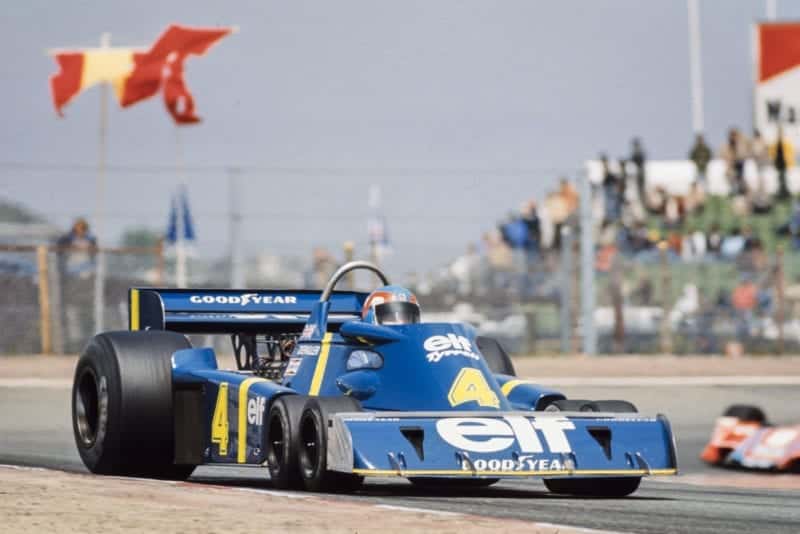
Patrick Depailler crashed on lap 25 after qualifying 3rd
Motorsport Images
Undeterred by his repeat performance Brambilla got the Marshals to help him back onto the track, and though some laps down, he pressed on. Unfortunately the March suspension was damaged and he soon had to retire when it broke. Laffite’s strong run in fifth place ended when his gear selection mechanism became deranged and he had to make a pit-stop for repairs, rejoining the race two laps down. As the Ligier had headed for the pits Mass had forced his McLaren past the six-wheeled Tyrrell, for Depailler was finding the feel of his brake pedal going “spongy” due to overheating fluid, and moved into third place. This was on lap 25 and one lap later the Tyrrell driver found himself in trouble braking into a sharp corner. Before he could make a pump on the pedal it was all over and Project 34/2 had spun off backwards into the catch-fences.
At 30 laps Mass had closed up behind Hunt and the two McLaren drivers were looking for signs of Lauda weakening in the leading Ferrari. They were now lapping the tail-enders, to add to Lauda’s discomfort and on lap 32 Hunt made his pass as they headed for the corner at the end of the straight. Lauda had no physical reserves, only will power, and that wasn’t enough; he knew he was beaten and let Hunt go through into the lead, followed two laps later by his teammate Jochen Mass. Poor Lauda was in real agony and physically would have given up there and then, but his mental condition was as strong as ever and mind-over-matter made him keep going in a secure third place. With the Ligier and the six-wheeled Tyrrell out of the running Nilsson had inherited fourth place, but Andretti had to watch the Swede disappear in the distance as his gearbox began to fail to select gears, and on lap 35 he had to give up at the pits, for a repair could not be made.
What had been the tail of the field had now become mid-field runners, hopeful of a place, while the stragglers could see themselves actually finishing. Scheckter was in a very uninspired sixth place and behind him Jarier, Reutemann, Watson, Amon and Pace were putting on a bit of a battle with very little at stake, until Watson spun the Penske out of the fray, resuming at the end of the field. Both of the Brahham-Alfa Romeos were running regularly, but not fast enough, being only capable of matching the lesser Cosworth-powered cars, while we all know that both Pace and Reutemann are capable of being at the front of a Grand Prix. At 45 laps Regazzoni began putting the pressure on Scheckter and the last of the March cars faded quietly away when Merzario retired with gear-selection problems, Stuck already having gone for similar reasons, after an excursion off the circuit. Perkins in the Dutch-owned Ensign was circulating tidily and keeping out of trouble but had to stop and change a tyre, and Alan Jones was keeping ahead of Ickx and Leclere, but not really in the picture and shortly to be lapped by the leaders, while Pryce was with them hut not really making much progress. The Cosworth engine in the Penske blew up pretty dramatically and those following skated about on the oil, and then Scheckter’s Cosworth engine broke the belt driving the engine auxiliaries and that was that. On lap 57 Regazzoni found petrol spraying onto his legs and stopped at the pits, throwing away fifth place and lost three laps while the pipe to the fuel pressure gauge was cut and nipped up. The gauge had broken internally and was leaking the petrol.
At the front the two McLarens were in complete charge of things running one behind the other in a demonstration of strength, not luck. Lauda had settled for third place, grimly determined to see the 75 laps out, while Nilsson was very happy in fourth place. Troubles and retirements had let Jarier into fifth place for a short time, until an electrical failure stopped him racing, Reutemann sixth and Amon seventh, the rest having been lapped by the leaders.
The confidence in the McLaren pit was rudely shattered at the end of lap 65 when Mass coasted up the pit lane with a heat haze enveloping the engine. There was no need to look under the cover for the Nicholson-McLaren Cosworth engine had blown up in a very big way, and Hunt was on his own and was given a signal to take it easy. Never one to miss an opportunity Regazzoni had rejoined the race three laps down but just behind the leading McLaren, and the swarthy Swiss took great delight in hounding the McLaren just when its driver wanted to relax a bit. Obviously Hunt knew it was Regazzoni and that he was some laps behind, but nevertheless there was always the thought that it might have been Lauda having a resurgence of stamina, and pit signals have been known to be wrong. One Ferrari looks like any other Ferrari. At 70 laps Jones had his gear-change mechanism break on the Surtees and he had to compete the remaining laps stuck in one gear and this dropped him from eighth place to ninth as Pryce eventually got by, but apart from that the Spanish GP ran to a close without drama. That was yet to come.
It had been a nice interesting race, satisfactory in all respects, with a lot of satisfied people about. Hunt was a worthy winner, showing that a small weakness in the Ferrari team can be exploited, with determination. New cars had shown up well, the new “speedlimiting” regulations had been seen to he in force, but the effect wasn’t noticeable, the weather was still fine and sunny and after putting laurel wreaths on Hunt and Nilsson (Lauda was too clapped out to attend the ceremony), the King took off in his big white helicopter, once more covering everyone with a layer of dust and rubbish. The McLaren team were joyful, the Ferrari team proud of their gritty little Austrian World Champion, Team Lotus were falling all over Nilsson and the Ensign team were overjoyed with the performance of their brand new car. Even Perkins and the Dutch boys were happy with finishing in their first Grand Prix. But then the whole scene turned into a farce, equalled only by the Le Mans 24-hour race when it was at its best. Hunt’s McLaren was measured and found to be wider than the permitted maximum, and the Ligier-Matra was found to have the end of its aerofoil sideplates more than 80 cm. behind the axle line.
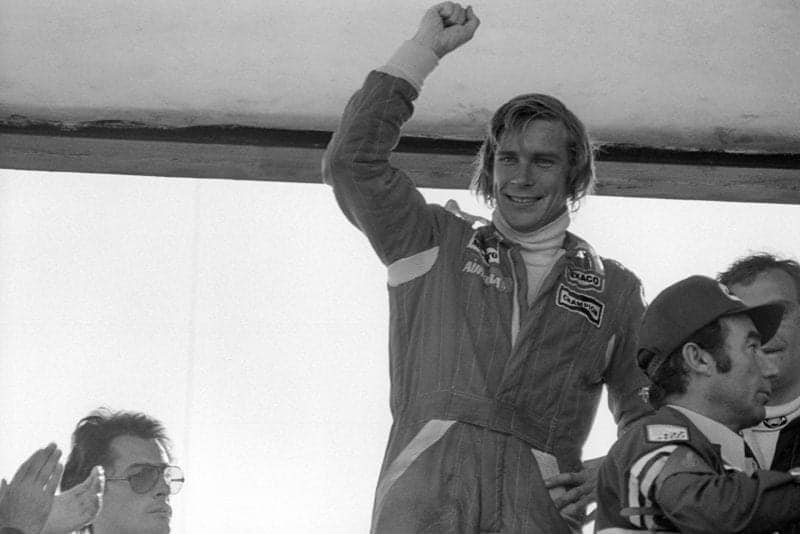
Hunt is jubilant on the podium
Motorsport Images
For the motor racing enthusiast the Spanish GP was over, but for those people who are running races, such as the CSI and the Spanish organisers, and those who think they are running the races, like the Formula One Contractors’ Association, it was far from over and at 9 p.m. or thereabouts Hunt and Laffite were disqualified and removed from the results on paper, but that is another story altogether, related elsewhere in this issue.—D.S.J.
